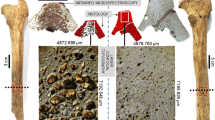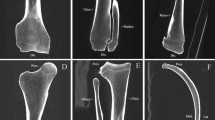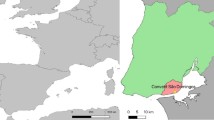Abstract
Red-colored bones were first found in Guishan goats in the 1980s, and they were subsequently designated red-boned Guishan goats. However, the difference remains unclear between the bone mineral density (BMD) or elemental composition in bones between red-boned Guishan goats and common Guishan goats. Analysis of femoral bone samples by dual-energy X-ray absorptiometry and inductively coupled plasma optical emission spectrometry revealed an increase in bone mineral density in the femoral diaphysis and distal femur of red-boned Guishan goats at 18 and 36 months of age. The data revealed that BMD increased in both the red-boned and common Guishan goats from 18 to 36 months of age. The data also indicated that the ratio of the BMD values of red-boned to common Guishan goats was higher at 36 months of age than they were at 18 months of age. Furthermore, the levels of calcium, phosphorus, magnesium, barium, zinc, manganese, and aluminum were significantly higher in red-boned Guishan goats than common Guishan goats at 18 and 36 months of age. The results indicate that the red-boned Guishan goats were linked to the elevated levels of mineral salts observed in the bones and that this in turn may be linked to the elevated BMD levels encountered in red-boned Guishan goats. These reasons may be responsible for the red coloration in the bones of red-boned Guishan goats.
Similar content being viewed by others
References
Fengying G, Changrong G, Zhenhui C, Junjing J (2009) Study on the chromosomal karyotype and chromosome banding of Guishan goats and red-boned Guishan goats. China Anim Husband Vet Med 36:79–83
Dahai G, Zhiqiang X, Changrong G (2011) Study on the physical meat indicators in Yunnan Guishan red-boned and normal boned goats. China Anim Husband Vet Med 38:210–213
Tao C, Wenming D, Changrong G (1999) Determination of body ruler and slaughter performance in Yunnan goats. Grass Feed Live 3:15–18
Scott A, Norton MD, Fort MSC, Huachu C (1998) Useful plants of dermatology. IV. Alizarin red and madder. J Am Acad Dermatol 39:484–485, Arizona
Puchtler H, Meloan SN, Terry MS (1969) On the history and mechanism of alizarin and alizarin red S stains for calcium. J Histochem Cytochem 17:110–124
Kiel EG, Heertjes PM (1963) Metal complexes of alizarin. I—the structure of the calcium–aluminium lake of alizarin. J Soc Dye Colour 79:21
Kiel EG, Heertjes PM (1963) Metal complexes of alizarin. II—the structure of some metal complexes of alizarin other than Turkey red. J Soc Dye Colour 79:61
Kiel EG, Heertjes PM (1963) Metal complexes of alizarin. III—the structure of metal complexes of some 3-derivatives of alizarin. J Soc Dye Colour 79:186
Kiel EG, Heertjes PM (1963) Metal complexes of alizarin. IV—the structure of the potassium and calcium salts of alizarin and of 3-nitroalizarin. J Soc Dye Colour 79:363
Richter D (1937) Vital staining of bones with madder. Biochem J 31:591–595
Manolagas SC (2000) Birth and death of bone cells: basic regulatory mechanisms and implications for the pathogenesis and treatment of osteoporosis. Endocr Rev 21:115–137
Sudo H, Kodama HA, Amagai Y (1983) In vitro differentiation and calcification in a new clonal osteogenic cell line derived from newborn mouse calvaria. J Cell Biol 96:191–198
Fratzl-Zelman N, Fratzl P, Horandner H (1998) Matrix mineralization in MC3T3-E1 cell cultures initiated by beta-glycerophosphate pulse. Bone 23:511–520
Saltman PD, Strause LG (1993) The role of trace minerals in osteoporosis. J Cell Biol 12:384–389
Rico HN, Gomez-Raso M, Revilla ER, Hernandez C, Seco E, Paez E et al (2000) Effects on bone loss of manganese alone or with copper supplement in ovariectomized rats a morphometric and densitomeric study. Eur J Obstet Gynecol Reprod Biol 90:97–101
Medeiros DM, Plattner A, Jennings D, Stoecker B (2002) Bone morphology, strength and density are compromised in iron-deficient rats and exacerbated by calcium restriction. American Soc Nutri Sci 31:3135–3141
Acknowledgments
This study was supported by the National Nature Science Foundation of China and the Foundation of Yunnan Province (U0836601).
Author information
Authors and Affiliations
Corresponding authors
Rights and permissions
About this article
Cite this article
Wu, C., Wang, J., Li, P. et al. Bone Mineral Density and Elemental Composition of Bone Tissues in “Red-Boned” Guishan Goats. Biol Trace Elem Res 149, 340–344 (2012). https://doi.org/10.1007/s12011-012-9442-5
Received:
Accepted:
Published:
Issue Date:
DOI: https://doi.org/10.1007/s12011-012-9442-5




